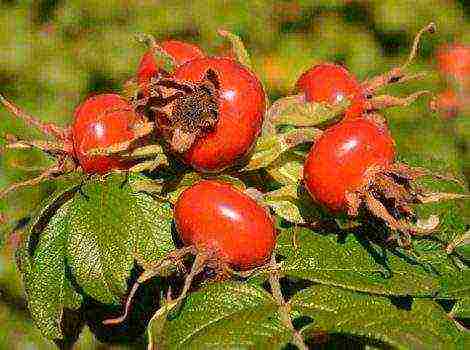Content
Spirea is prominent among the ornamental shrubs. For lush flowering, unpretentiousness and frost resistance, she won the love of summer residents, landscape designers and breeders. But some types and varieties of spirea are held in high esteem.
The name of this shrub, translated from Latin, means "bend": the branches of the plant form a graceful arc. People sometimes call the spirea a meadowsweet, but this is not true. Meadowsweet and spirea have similar inflorescences, but they are different plants.
Spirea is a shrub of the Rosaceae family, which has almost a hundred species. All of them are undemanding to growing conditions, multiply easily, grow quickly, bloom for a long time, tolerate a haircut well and have many other advantages. Today, spirea is widely used to decorate summer cottages and city parks.
Spirea can live on the site for tens of years
The height of the spirea can vary from 50 cm to 2.5 m. The flowering time - depending on the species - occurs in spring, summer or autumn. The shape of the crown is spherical, weeping, pyramidal, cascading or erect. In addition to flowers, spireas also decorate the site with decorative foliage. Many varieties have been bred with an openwork leaf shape. In autumn, they change color to bright red, yellow, orange.
All types of spirea are divided into two large groups: spring-flowering and summer-flowering.
Spring flowering spireas and their varieties
Spring species of spirea form inflorescences of predominantly white and cream shades. Flowering is usually very lush, at this time the bush becomes like a white cloud. Due to this, spring spireas are sometimes called May snow. We list some of the most common types of this type.
Spirea Wangutta (Spiraea x vanhouttei)
This hybrid spirea is a medium to tall shrub, which at the end of May is covered with a dense cascade of white flowers. Tall varieties look great singly, while lower varieties look great in mixed plantings. Spirea Wangutta is also suitable for hedges.
The most popular variety is Pink Ice, with variegated leaves and creamy buds.
Spirea Wangutta Pink Ice is an ideal plant for specimen planting
Spirea oak-leaved (Spiraea chamaedryfolia)
One of the first to bloom - in early or mid-May. The shrub grows up to 1.5 m, sometimes slightly taller. This species reproduces well with root shoots, so it is often planted in city parks. Also, the oak-leaved spiraea easily tolerates a haircut, therefore it is excellent for hedges.
Spiraea oak-leaved - not only an ornamental plant, but also a good honey plant
Spirea nippon (Spiraea nipponica)
It is a lower, spherical shrub. Its height usually does not exceed 1 m. It blooms very profusely in late May and June. The varieties Snowmound and Halvard Silver are especially effective.
Spirea Nipponskaya varieties Snowmound (left) and Halvard Silver (right)
Spirea Thunberg (Spiraea thunbergii)
In the wild, Thunberg spirea is found on mountain slopes and in valleys. The bush reaches a height of no more than 1.5 m.Its dense branches are covered with graceful leaves, which change their color from green to orange in autumn. Lush white inflorescences adorn the spirea from May to June. The plant prefers sunny places and in the middle lane can freeze a little during severe winters.
The most popular varieties are Fujino Pink (with pale pink inflorescences on drooping branches) and Ogon (with golden-green willow-like leaves and white inflorescences).
Spirea Thunberg Fujino Pink (left) and Fire (right)
Spirea crenate (Spiraea crenata)
Spectacular shrub up to 1 m in height with a loose crown and obovate leaves of a grayish-green color with a characteristic crenate edge and protruding veins. Yellowish-white flowers are collected in corymbose inflorescences.
Thanks to the well-developed root system of the spirea, the crenate is not afraid of frost or drought.
Spirea gray (Spiraea x cinerea)
This is a hybrid of Spiraea hypericifolia and whitish-gray spirea (Spiraea cana). The plant is a shrub up to 2 m high with branched shoots, gray-green pointed leaves and white flowers, collected in loose inflorescences-shields. This spirea blooms in May - early June.
The Grafsheim variety is especially interesting. It is a small densely branched shrub with arched drooping branches, narrow leaves and large white double flowers.
Grafsheim is not only a very beautiful, but also a perfect unpretentious variety. The bush grows very quickly, tolerates a haircut well, is not afraid of the cold and does not need good lighting
Summer flowering spireas and their varieties
In spring spirits, flower buds are formed on two-year-old shoots, and in summer ones, on the shoots of the current season. Therefore, they are often cut off. Summer-flowering spireas are distinguished by inflorescences, as a rule, of different shades of red and pink. Here are the most famous species.
Spirea willow (Spiraea salicifolia)
Usually it grows from 1 to 2.5 m. From the end of June, the upright shrub is covered with light pink inflorescences. Light foliage, similar in shape to willow, takes on a red tint in the fall.
Willow spirea is most often grown in hedges.
The most popular in gardens is the large-flowered form of willow spirea (f. Grandiflora) - with more lush light pink flowers.
White-flowered spirea (Spiraea albiflora)
It is named so because it is one of the few summer species with white flowers. It blooms for a long time from the second half of summer, exudes a pleasant aroma. The bush is usually low - 1-1.5 m.
Of the bred varieties, it is worth noting Macrophila. Its foliage changes color twice: young leaves are red, gradually they turn green, and in autumn they turn yellow.
Spirea white-flowered variety Macrofila is famous for its large leaves
Japanese spirea (Spiraea japonica)
This is the most common spirea. It has a small height (usually about 50 cm), blooms for one and a half to two months, starting in mid-summer. Looks good in curbs and group plantings.
Among the many varieties, one of the most spectacular is Shirobana. On one bush, flowers of white, pink and red shades are found at the same time. Also good varieties are Golden Princesses (distinguished by golden foliage), Gold Mound (leaves are also golden, but darker and with a pink tip).
Japanese spirea varieties Shirobana, Golden Princesses and Gold Mound (from left to right)
Spirea Douglas (Spiraea douglasii)
Shrub up to 1.5 m high with straight, reddish-brown, pubescent shoots, oblong-lanceolate silvery-green leaves and dark pink flowers, collected in narrow pyramidal or paniculate inflorescences. The plant blooms from July to August for approximately 45 days.
Spirea Douglas is often used to strengthen slopes and slopes.
Spirea Bumalda (Spiraea x bumalda)
This hybrid of Japanese and white-flowered spirits in gardens is found even more often than its "parents". Spirea Bumalda is a short shrub (up to 75 cm) with a spherical crown, erect branches, ovate-lanceolate leaves and pink or crimson flowers.
The most popular varieties:
- Gold Flame (pink flowers, leaves when blooming are bronze-orange, later - golden-yellow, in summer - greenish-yellow, and in autumn - copper-orange);
- Darts Red (inflorescences are deep crimson, leaves are pinkish when blooming, in summer they are dark green, and in autumn they are red).
Spirei Gold Flame (left) and Darts Red (right)
Spirea Billard (Spiraea x billardii)
This is a winter-hardy hybrid of Douglas spirea and willow spirea. The bush grows up to 2 m in height, differs in broadly lanceolate leaves and pubescent bright pink inflorescences that adorn the plant in the second half of summer.
The most popular variety is Triumfans (with purple-pink spike-shaped inflorescences).
Spirea Billard Triumfans is suitable for creating hedges, as well as for group and single plantings in gardens and parks
Spirea goes well with other plants. It can be flowering shrubs and strict conifers. Planting a spirea allows you to cover the leafless part of the lilac and other shrubs and trees bare from below. Miniature varieties will find their place among stones on an alpine slide or in a rockery. And from tall spirits beautiful hedges are obtained. Select a corner in the flower garden for a charming spirea - and you will not regret it!
Spirea is a genus of ornamental deciduous shrubs, of the pink family. Another name is meadowsweet.

Spirea is quite unpretentious in care. There are about a hundred varieties of this plant.
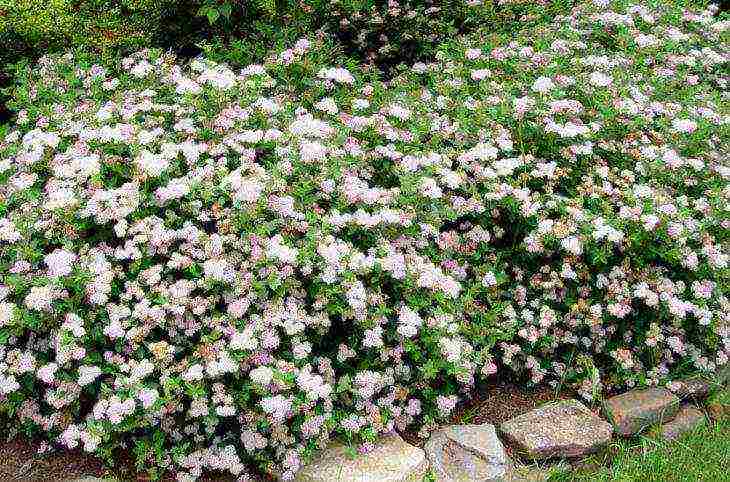
Spireas grow in steppe, forest-steppe and semi-desert areas. The first mention of meadowsweet dates back to the 15th century. Four centuries later, V. Dahl entered all the information about this plant into his dictionary.
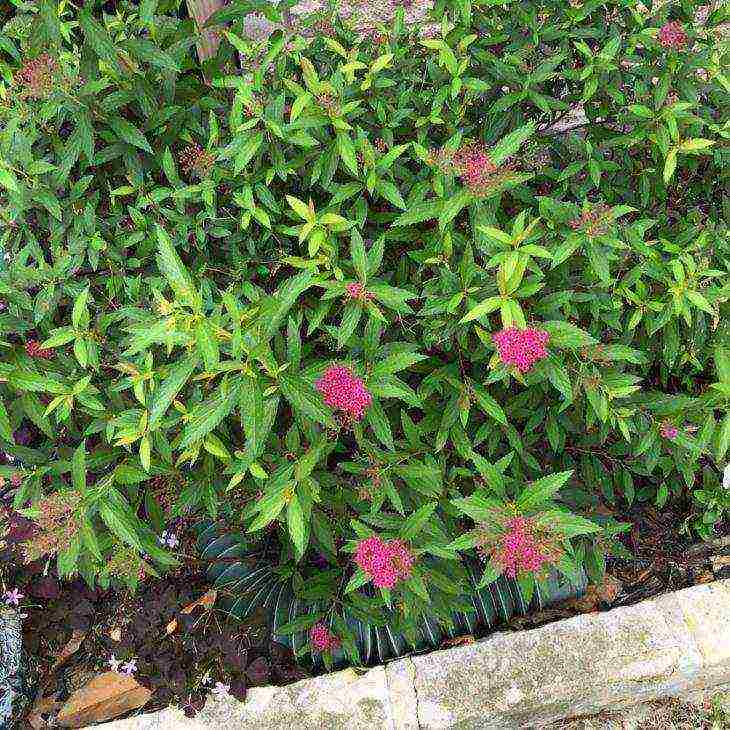
Today there are a large number of varieties of spirits that stand out for their decorative appearance, frost resistance and long flowering period.
Spirea appearance
Spirea shrub can be miniature (up to 15 cm high) and high (up to 2.5 m).
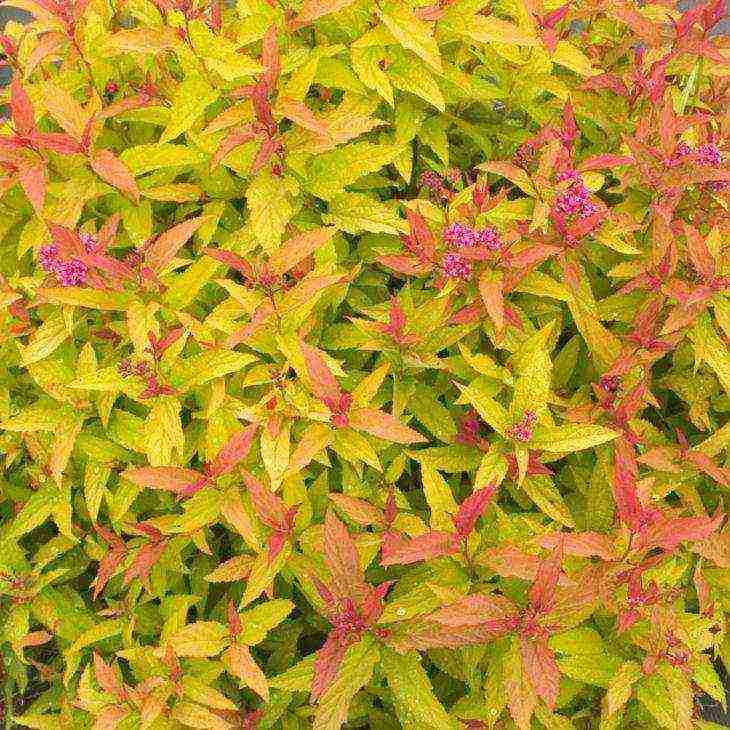
The plant has a fibrous root system located at a shallow depth. Branches can either spread along the ground, or be erect, spreading or lying. Their color ranges from light brown to dark brown. The bark may delaminate longitudinally.

The petiole leaves are arranged alternately, can have a lobed, lanceolate or rounded shape. The flowers are small, but their number is quite large, they form a variety of inflorescences. Their shades are different: from snow-white to bright crimson. Flowers can be distributed both evenly throughout the branch, and only at the tips of the shoots.

Reproduction occurs in four ways:
- division of the bush;
- seeds;
- layering;
- grafting.
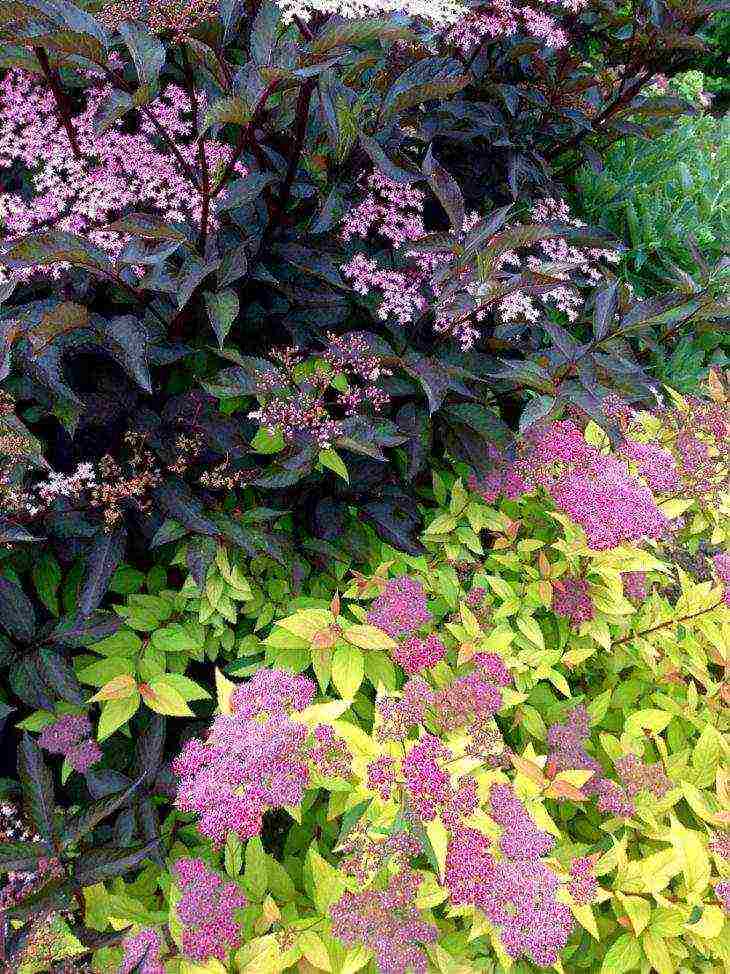
Spirea is used for flower beds and for creating hedges. Any rockery and stone garden cannot do without dwarf meadowsweet.
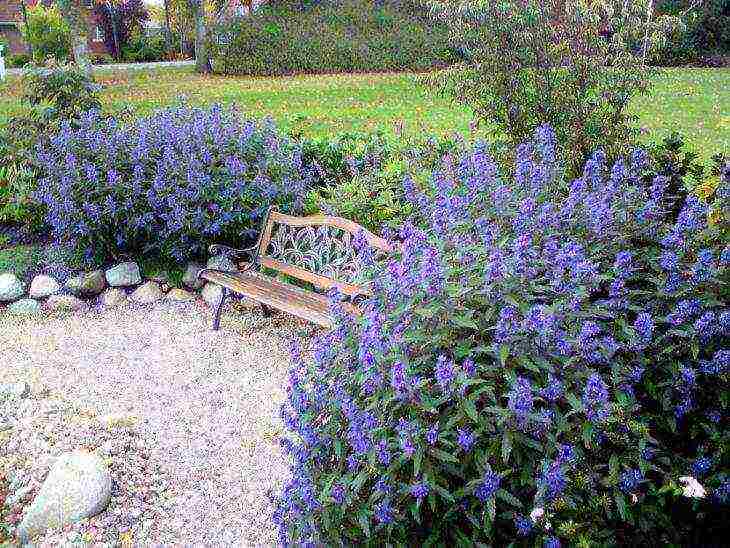
You can also make living green carpets from miniature spirits. A single meadowsweet shrub also looks good.

Varieties of spirits
The types of spirea are divided depending on the flowering period:
Spring blooming. They are distinguished by early flowering and flowers of various tones of white, which appear in the 2nd year of the life of the branches. These varieties have a rather lush bush shape.
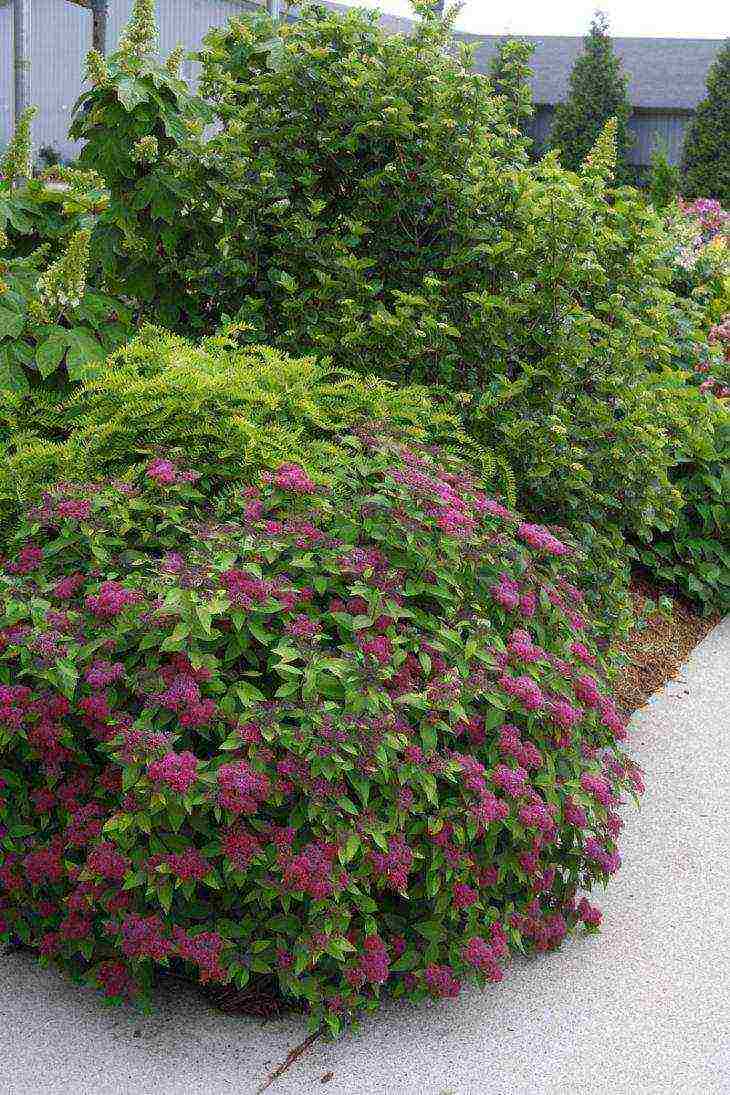
The spring-flowering species include gray spirea, gray spirea Grefsheim, Vankutta spirea, Argut spirea. All of them belong to white spireas;
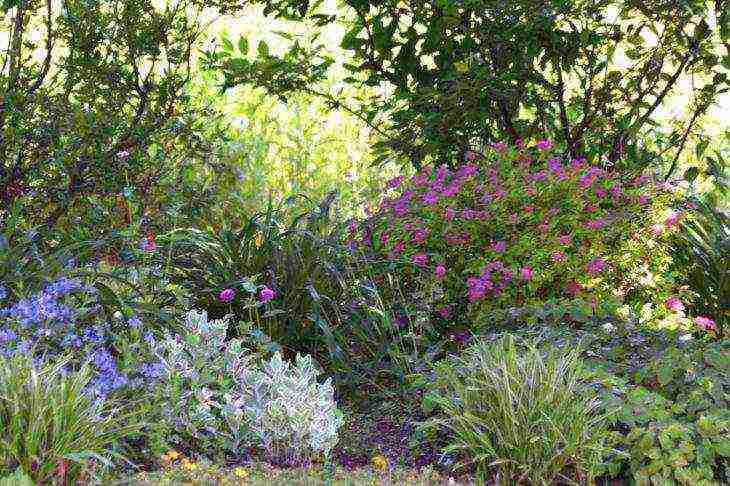
Summer blooming. Blossom in summer. Flowers bloom at the tips of young branches, and old branches dry out over time. Flowers can be of different colors. A striking representative is Japanese spirea. It has many varieties.

There are also other varieties of spirits that bloom in the summer. An example would be willow spirea, spirea of Boomald, Douglas, Billard and others.
How to grow spirea
Planting and caring for spireas is not very difficult. The land for meadowsweet should be leafy or soddy. For a shrub, a mixture of earth, sand and peat in a 2: 1: 1 ratio is perfect.
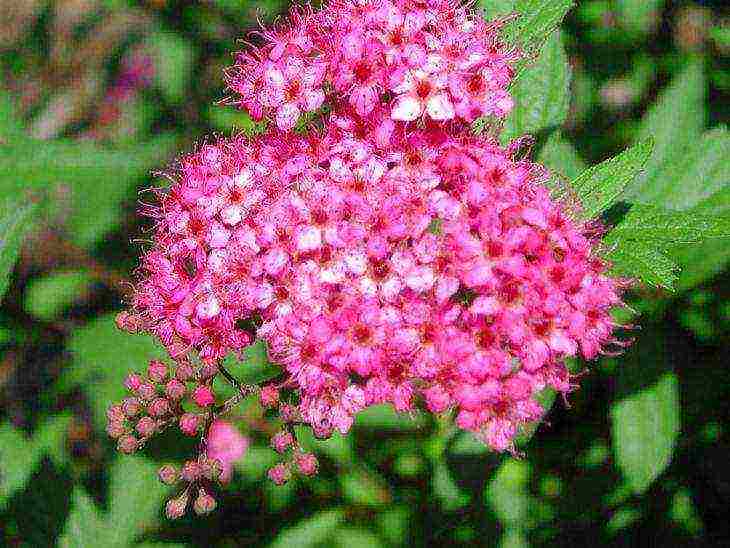
Drainage is imperative. The hole in which it is planned to plant the spirea should be 1/3 larger than the size of the roots of the bush, its depth should be at least 0.5 m. It is very important that the root collar is located on the surface of the earth.

It is recommended to plant meadowsweet on a cloudy day, the best option is if it is raining.The best month for planting is September.
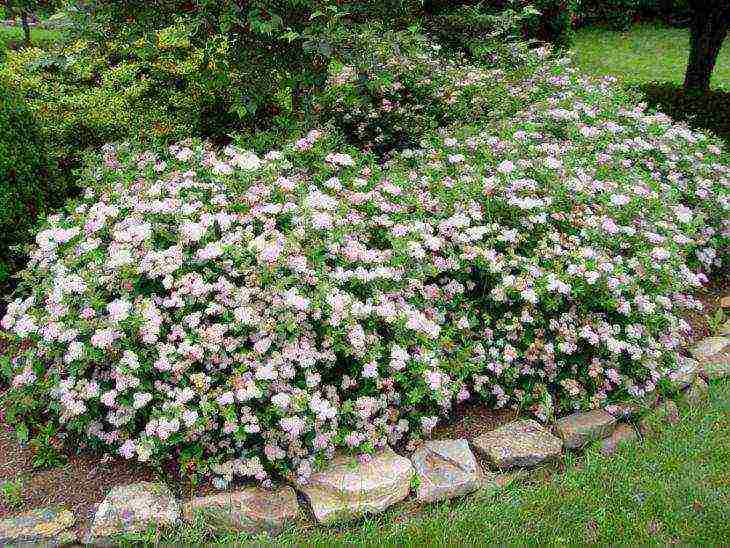
The plant can also be planted in spring. Spirea favorably tolerates the neighborhood of juniper, fir trees, thuja.
The meadowsweet prefers well-lit places. Some varieties feel great in a shaded area. The soil must be fertile, it is recommended to loosen it regularly. A drainage layer is required. It is advisable to mulch the bush immediately after transplanting. Peat is perfect for this.

The plant loves moderate watering - 15 liters of water twice a month. Systematic weed removal is a must.
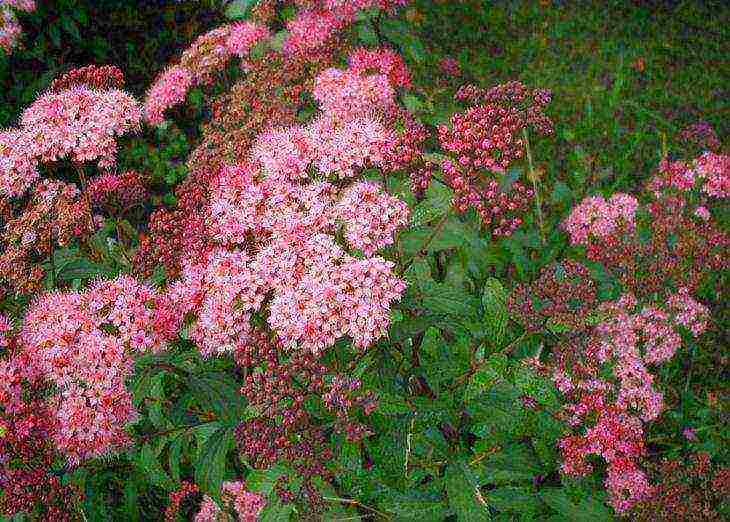
You can feed the bush using a complex fertilizer. Top dressing is recommended after cutting the plant, and in July it is a good idea to use a mixture of manure and superphosphate (10 g per 10 l).
Spirea can suffer from aphids and spider mites. To get rid of the tick, karbofos is recommended, and pyrimor will perfectly destroy aphids. But, in general, spireas are quite resistant to pests.
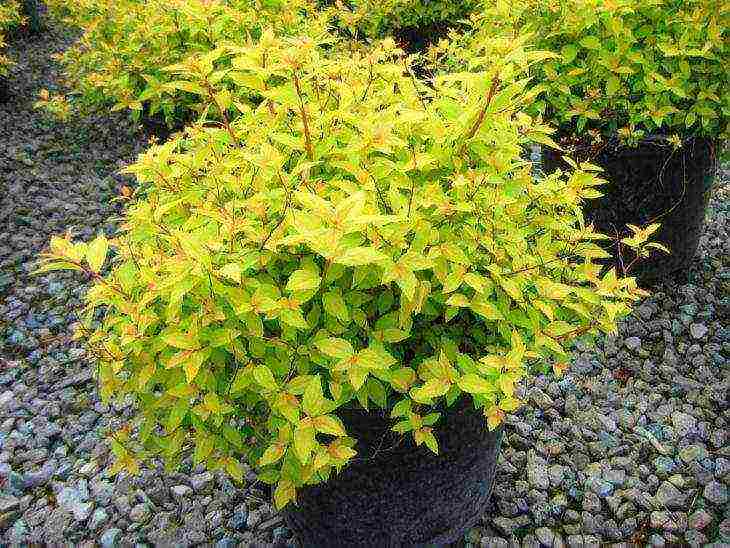
Spirea needs systematic pruning, as it grows over time. In spring-flowering varieties, once a year in spring or summer, only the ends of the shoots are cut, and after 7-14 years it is necessary to remove all old branches, for which the bush is sheared to a hemp state. A new bush is formed from a new growth (5-6 shoots).

After a couple of years, poorly growing and old branches are cut again. Pruning of late-flowering meadowsweets is practiced in the first spring months. This procedure should be carried out at least once a year. The more you cut off the branches, the more powerful the new branches will be.
It is necessary to get rid of old shoots in a timely manner. The four-year-old shrub can be pruned to a height of 30 cm each year.

Ornamental spirea bushes will perfectly decorate your garden. They are easy to care for, they are quite frost-hardy, and their lifespan is long enough. It is a great choice for gardeners.
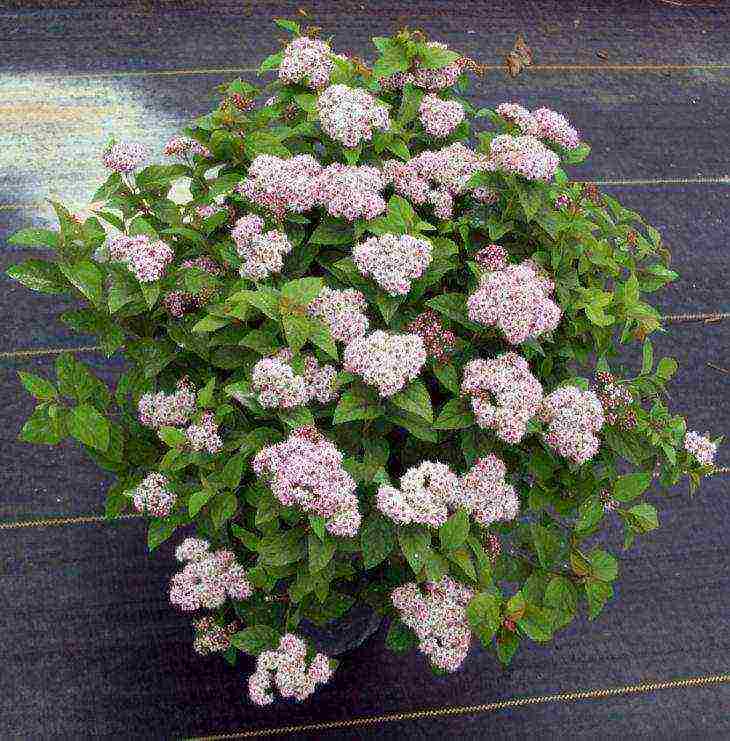
Spirea photo

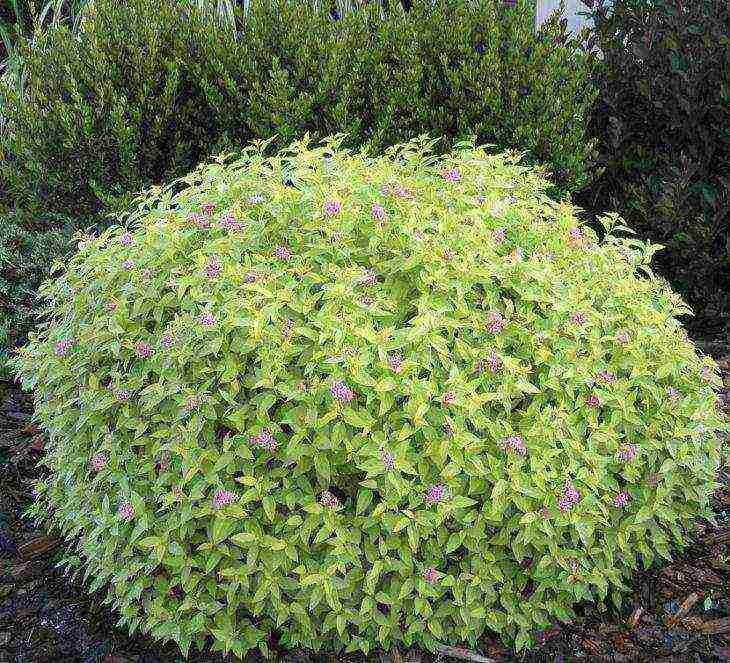




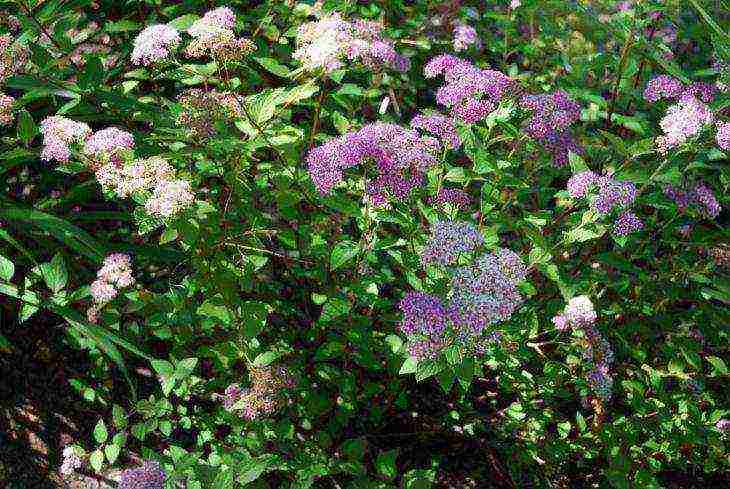

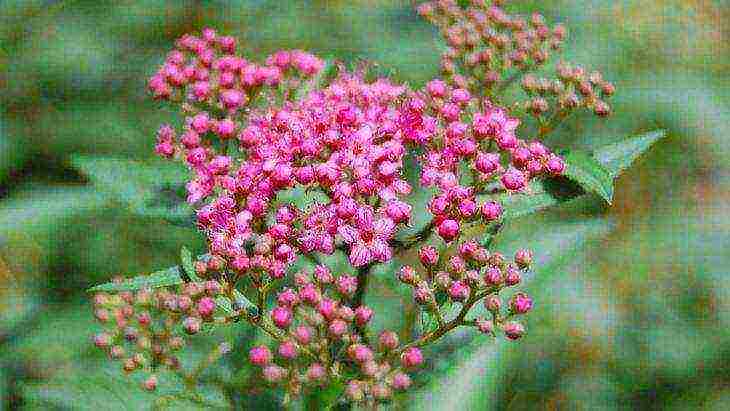
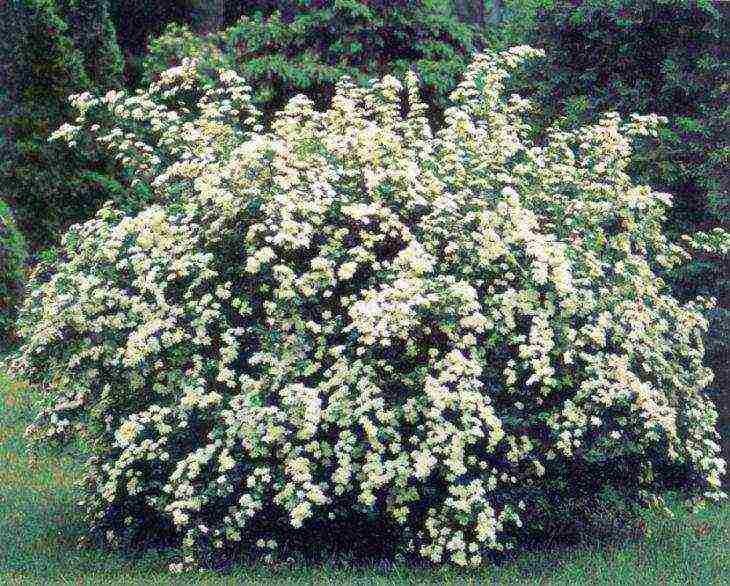
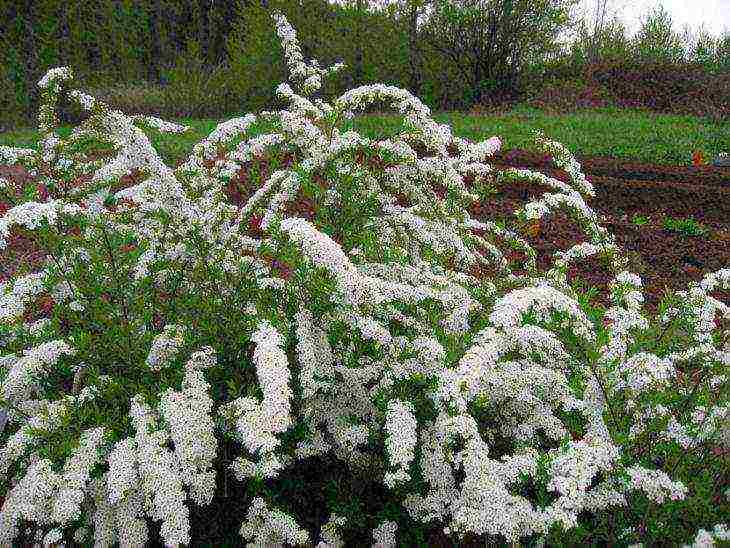


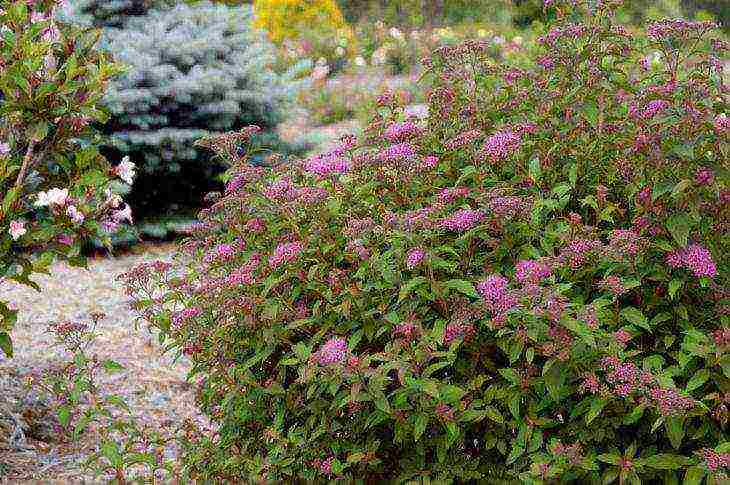
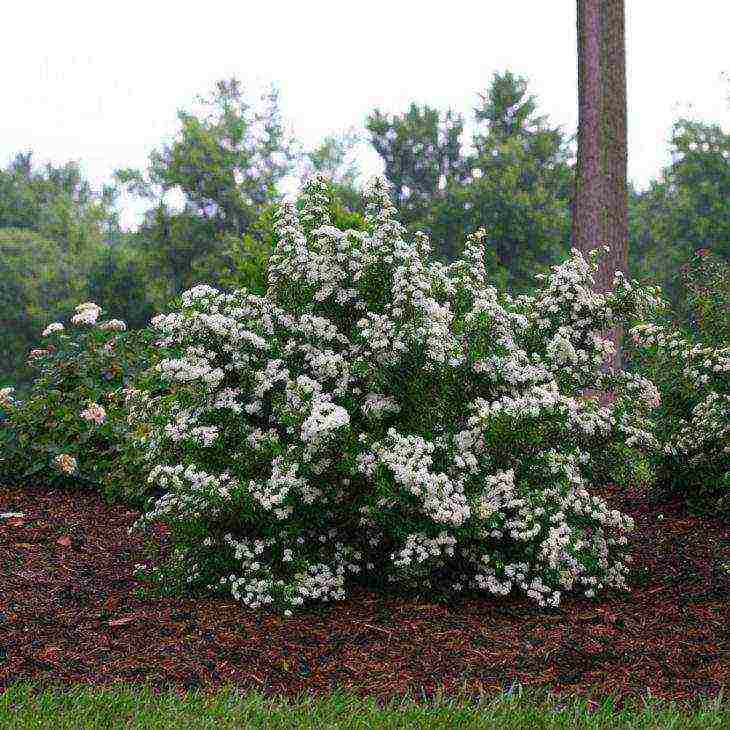

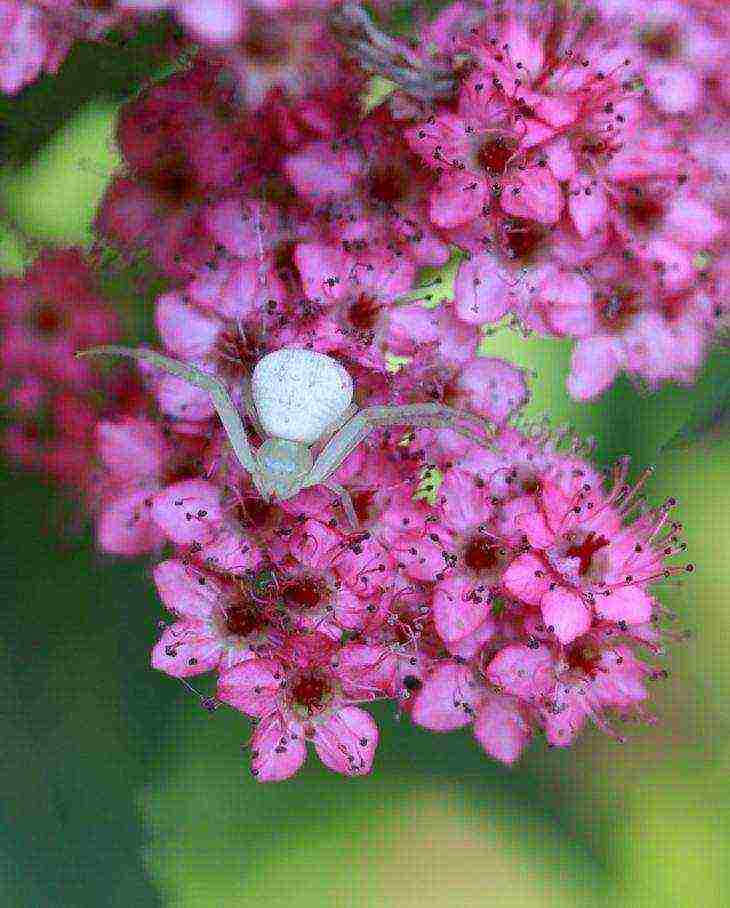
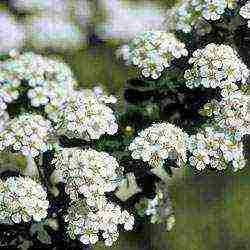 Spirea is a genus of deciduous ornamental shrubs of the Pink family. They are found in forest, forest-steppe and semi-deserts, as well as mountainous regions in the north. In the Asian part, one of the borders passes through the Himalayas, the other through the territory of Mexico.
Spirea is a genus of deciduous ornamental shrubs of the Pink family. They are found in forest, forest-steppe and semi-deserts, as well as mountainous regions in the north. In the Asian part, one of the borders passes through the Himalayas, the other through the territory of Mexico.
There are about 100 varieties of spirits. Some of them are frost-resistant, tolerate drought and need good quality soil. Reproduction takes place by cuttings, dividing bushes, and also growing from seeds.
Description of spirea
Spireas are distinguished by a wide variety of shapes and colors, depending on the type and variety of the bush. Some specimens tend to change color from one to another closer to autumn. The height of certain species may exceed the 2 m mark.
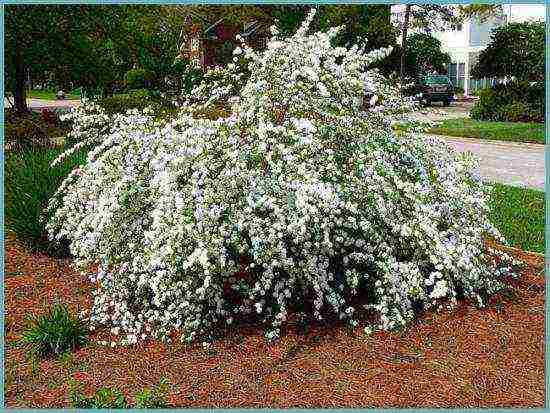
Delicate flowering of spirea will decorate your garden
The flowering of spring varieties is short, in summer species it is longer and more massive. The first flowering occurs in the 3rd year of the plant's life, and this may be the opening of only a few buds.
The range of application of plants is very diverse. They are used for medicinal purposes, forestry, landscape design. The root system of plants perfectly strengthens the soil.

When choosing a variety, pay attention to the flowering period of the crop.
All spireas can be divided into two large groups:
- A group of spring-flowering spirits.
- A group of summer-flowering spirits.
Spring flowering spireas: characteristics of varieties
The category includes representatives of spirits, the flowering of which occurs in spring or at the very beginning of summer. In these varieties, buds are laid on last year's branches. Therefore, shrubs should be cut off only after the culture has completely faded.
Spirea gray
Hybrid shrub. Bred in the middle of the 20th century. It has a branched structure with felt shoots. About 2 m high.
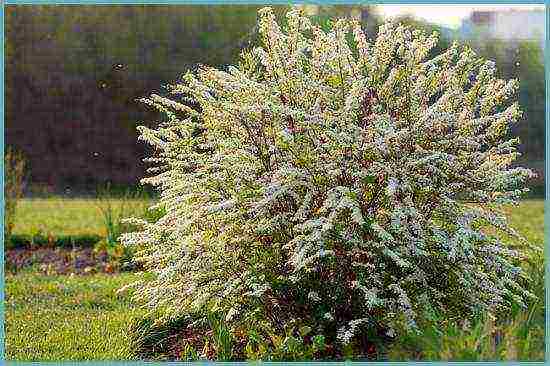
Spirea gray
The leaves of the shrub are pointed, grayish-green in color and are slightly lighter in places. Flowers of a snow-white color are collected in shields. At the crown of the shoot, inflorescences are sessile, a little further - on long deciduous branches.Flowering can begin in May, and by the end of June the spirea is already ripe. The size of the spirea is gray, a very compact shrub thanks to the falling branches with snow-white flowers. Suitable as a single or group planting. Blooming shoots look great in decorative bouquets.
Attention! Seed propagation of hybrid shrub species is impossible. Seedlings do not inherit the characteristics of the parent bush.
The most popular variety of this species is Grefsheim, a compact shrub with drooping branches that look like arches. Narrow-leaved flowers are double, white. They gather in dense inflorescences along the stems.
It is a wintering species.
Spirea Argut
The second name of the species is spirea sharp-toothed. It is a hybrid species of Tunberg spirea and multiflorous. Arguta is an early spirea that blooms first. Differs in special decorativeness and powerful flowering. After flowering, the garden turns into a beautiful openwork carpet. Height approximately 1.5–2 m. Has a large crown, graceful branches and narrow leaves of a rich greenish color.
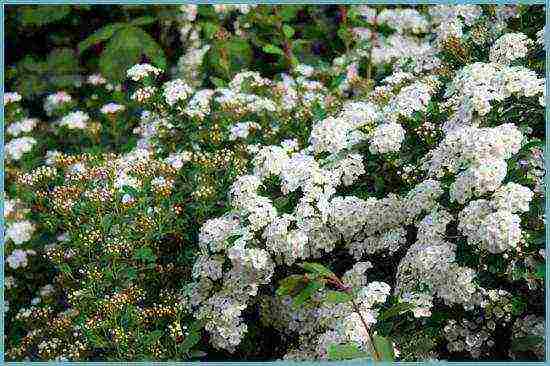
Spirea Argut
The bloom is profuse, begins in May and lasts quite a long time. Arguta flowers are snow-white, gather in inflorescences.
Compacta is a variety of Arguta spirea, which was developed in Germany in the 19th century. It is a shrub. Its height and circumference are 1.5 m. Distinctive features are long growth and instability to frost.
Spirea Wangutta
A shrub that is classified as a profusely flowering spirea on last year's branches. The height of the spirea is no more than 2 m. Flowering occurs in late May or early June. Flowers of white color are collected in brushes in the form of umbrellas. The color of the leaves is very unusual - blue-green.
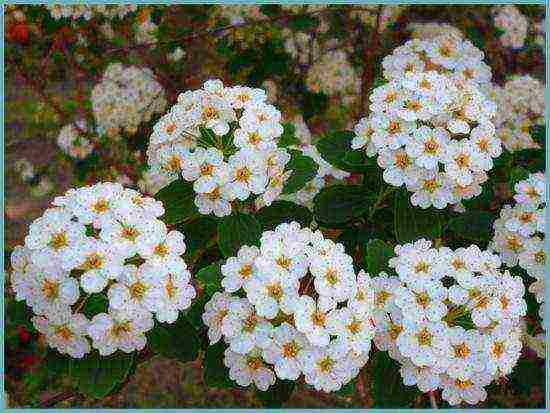
Spirea Wangutta
Look great in single plantings, as a hedge, and in combination with other shrubs or trees. The original compositions are obtained from Vargutta's spirea with maples and conifers.
Attention. Spirea Wangutta is the only spirea that has chosen limestone soils.
The famous Vargutta variety is Pink Ice (Catpan). The flowers on the tops of the shoots are cream-colored. Leaves are light green in color, gradually turning into cream-colored spots.
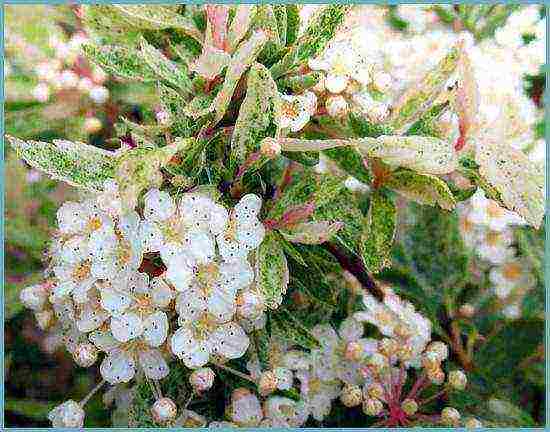
Pink Ice variety
The variety is winter-hardy, but meanwhile, the tips of the shoots can freeze in young animals.
Spirea crenate
Distributed in the southern latitudes of Russia, Western Europe, the Caucasus and Altai. Grows in meadows and steppes, as well as in mountainous areas.
The height of the shrub is no more than 1 m, it has a loose top. Its leaves are oblong, about 4 cm long, greenish-gray in color. It is the three-veined leaves that are the identification marks of the crenate spirea.
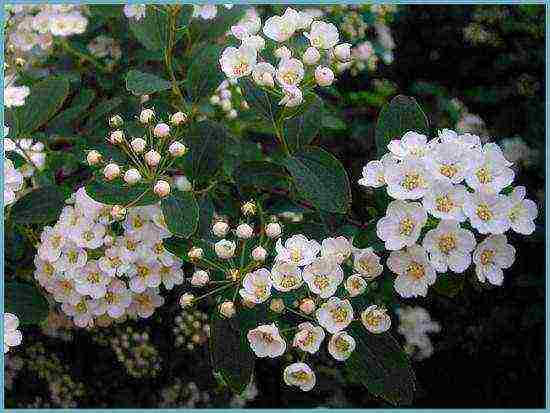
Spirea crenate
Flowers are white-yellow, collected in shields. The branches are short, leafy.
Flowering begins in June and lasts about 3 weeks. Fruiting occurs only in July.
Spirea crenate is not afraid of frost or drought, its root system is very developed. Good lighting is the key to abundant flowering. It is found mainly in nature, it is used in a forest-park landscape. Has hybrid varieties.
Spirea oak-leaved
Distributed in Siberia, Europe and Central Asia. A small shrub, its height is about 2 m. The leaves are bright, green in color, their length is 3.5–4 cm, they have pronounced outlines of teeth. In the autumn, the foliage turns yellow-orange.

Spirea oak-leaved
The flowers are snow-white, heavy. Under their weight, the branches bend to the ground. Blooms during May. The average period is 3 weeks. Shade-tolerant plant, not afraid of cold weather and lack of moisture.
Advice. This type of spirea is successfully used in landscape design as a hedge. This species can be cut to achieve the desired shrub shape.
Spirea nippon
Dense spherical shrub. Its height is only 1.5 m. The Japanese islands are the birthplace of culture. Leaves are round, crenate and whole. Their length is 4-5 cm.White flowers gather in inflorescences that stick around the shoot.

Spirea nippon
Flowering begins in May and lasts about 3 weeks. Nippon Spirea loves sunny areas, but can grow in a little shade. It is resistant to winter cold and undemanding to the composition of the soil.
Reproduction is carried out in three known options: dividing the bushes, growing from seeds and green cuttings.
It has many varieties, the most popular are Snowmound and Halward's Silver.
- Snowmound - shrub 1.5–2 m, crown circumference can reach 4 m. Curved branches. Leaves are green. The flowers are collected in inflorescences and are white.
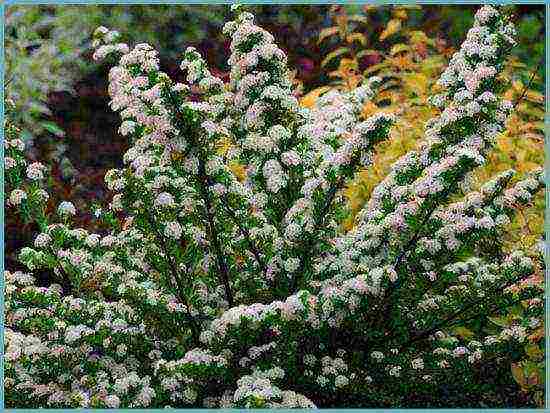
Snowmound cultivar
- Halward's Silver is a meter high shrub with dark green foliage. White flowers gather in bulging inflorescences.

Halward's Silver variety
Both varieties begin to bloom in June.
Spirea average
Shrub with erect stems. Its height varies from 1 to 2 m. The top of the head looks like a ball, dense. The leaves are oblong with teeth in one part, and infrequent hairs in the other. The foliage is green.
Flowering begins in May and lasts only 14 days.
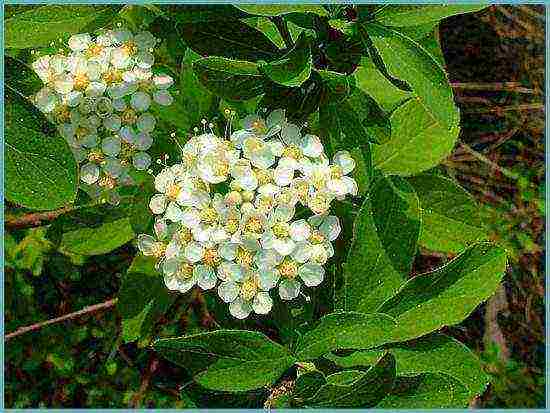
Spirea average
This species is not afraid of frost and shady areas. Propagated by the root system: it is well developed. The average spirea begins to bear fruit after 3 years of age. Can be cut, trimmed. Suitable for various types of landings.
In nature, it can be found in Siberia, Central Asia and the Far East.
Spirea Thunberg
Distributed in Korea, China and Japan. Grows on the slopes of the mountains.
Shrub, the average height of which is 1.5–2 m. Leaves are green, dense, 3.5–4 cm long, in autumn they acquire a yellowish tint. It is a decorative type.
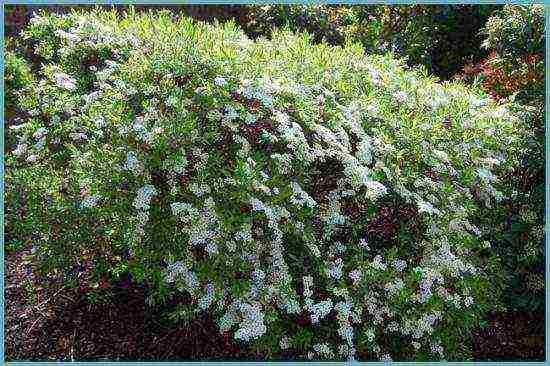
Spirea Thunberg
The flowers are white, collected in sessile umbrellas. The beginning of flowering of the plant is May, the end is June. Ripening of Thunberg spirea fruits occurs very quickly. Fruiting begins at the age of 3.
Growing from seeds and grafting are the main methods of propagation of this species. Spirea is a sun-loving plant with abundant flowering. In winter frosts, the extreme part of the shoots can freeze.
Summer flowering spireas: characteristics of varieties
In a plant of this category, inflorescences appear on young shoots of the current year. The next year, they will re-form on young branches, and the old ones will dry out. After three years of age, the old shoots are cut off, thereby rejuvenating the spirea. Thanks to its developed root system, the plant is considered durable. But despite this, it should be pruned once every four years.
Japanese spirea
The homeland of this extraordinarily beautiful species is the Japanese and Chinese expanses.
Japanese spirea is a small bush, the height of which is 1.5 m. The leaves are oblong. The upper part of the leaf is colored green, the reverse is bluish. After blooming, reddish tones appear.

Japanese spirea
The plant blooms throughout the summer season. Pink flowers are collected in inflorescences in the form of corymbose panicles.
Used to decorate flower beds and hedges. Spring pruning of the plant is a prerequisite.
Japanese spirea has many different varieties. Here are some of them:
- Little princess - undersized bush. Its height barely reaches half a meter. The circumference of the crown is about 120 cm. The crown is semicircular. Leaves are rich greenish color. The pink-red flowers gather in the shields. Flowering occurs in June or July. It grows slowly. Resistant to frost.

Little Princess variety
- Shirobana - a small shrub, the height of which is about 50–80 cm. The leaves are small, green, up to 2 cm long. The color of the flowers is different: from snow-white to pinkish-red. It usually blooms in July and August. It is in perfect harmony with other shrubs and plants. Alpine slides and lawns are decorated with it. Suitable as a decoration for mixborders.
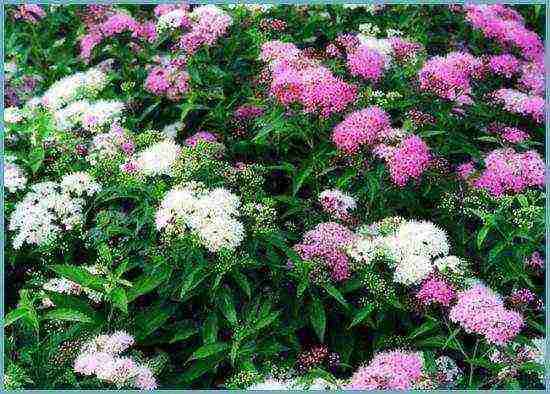
Shiroban variety
- Macrophylla - another of the varieties. Height up to 130 cm. It has long leaves. During blooming, they are purple-red, later they turn a little green, and towards autumn they acquire a yellowish tint. The flowers of the plant are lost against the general background of the striking variegation of leaves. Flowering begins in late July and lasts for one month.

Macrophylla cultivar
- Candlelight - a small bush with leaves of a pale creamy and yellowish tint. Height up to half a meter. In summer, the foliage of the spirea looks a little brighter and looks perfect with pink flowers.

Candlelight variety
- Gold flame - a shrub, the height of which is about 80 cm. It has orange-colored foliage, later it becomes deep yellow, and closer to autumn - copper color. Often, yellow foliage forms on the shrub. The flowers are small in size, pink and red.
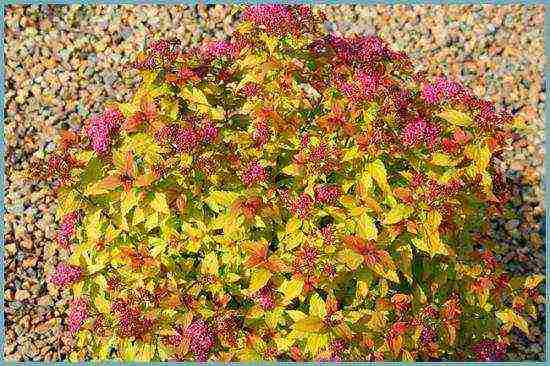
Gold flame variety
- Golden princess - a small bush. Its height is only 100 cm. Flowers are yellow and pinkish.
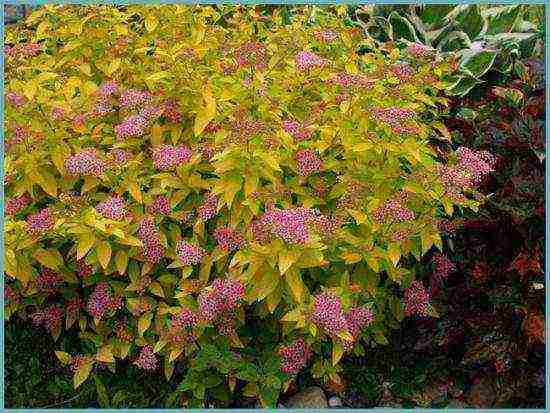
Golden Princess variety
- Gold mound - mini-variety 25 cm high. Differs in small size. Leaves are rich golden color. The flowers are pink. Flowering occurs in the middle of the summer season.
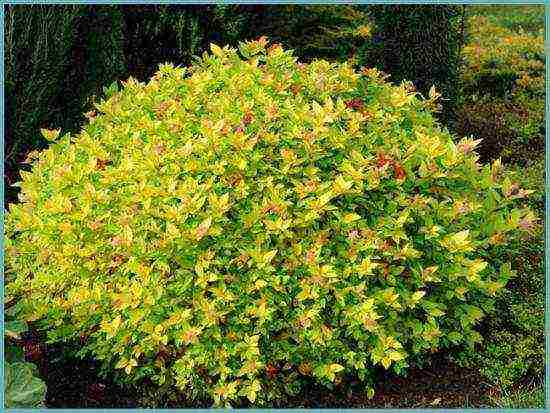
Gold Mound grade
Spirea white
A very common species in our country. It has been grown since the 18th century.
A small bush. By the age of ten it grows 160 cm. It has ribbed, drooping red-brown shoots. The leaves are sharp, 6.5 cm long and 2 cm wide. White flowers gather in panicle-like pyramids.
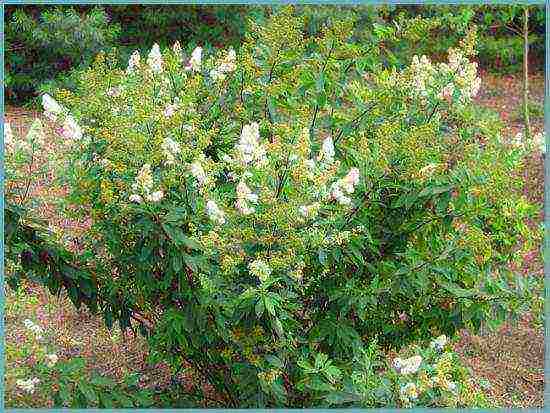
Spirea white
Flowering occurs annually in July. Its duration is about a month. Ripening usually occurs in October.
The plant loves moist soils and moderate watering. Grown from seed or propagated by cuttings.
Birch spirea
Found in forests, mountain slopes and the seaside. It can be found in Siberia, the Far East, Japan and Korea.
Photophilous shrub, but feels good in the shade. It is under protection in the reserve.

Birch spirea
It owes its name to the similarity of its own foliage with birch leaves. They are ovoid, the length is about 4 cm, and the width is 1.5-2 cm. The height of the shrub is about 60 cm. The crown is spherical. The flowers are white and pinkish, gather in the shields.
Flowering lasts from June. Duration is one month.
Spirea Billard
Hybrid species of Douglas spirea and willow leaf. It is a winter-hardy plant, therefore it grows well in the northern latitudes of our country.

Spirea Billard
It is a small shrub with spreading branches. It reaches a height of 200 cm. It has wide leaves. The flowers are pink. They are collected in inflorescences in the form of pyramids. Flowering occurs during the summer season and before the onset of the first cold weather.
Maturation does not occur, since Billard's spirea is a hybrid species.
Spirea Bumald
A hybrid species of Japanese and white-flowered spirea. A beautiful plant, sometimes it is difficult to distinguish it from the Japanese spirea itself.
Its height is 75–80 cm. Shoots are ribbed, branches are erect. The leaves are sharp, about 7.5 cm long. There are species with flowers ranging from pinkish to dark carnation. Blooms throughout the summer.
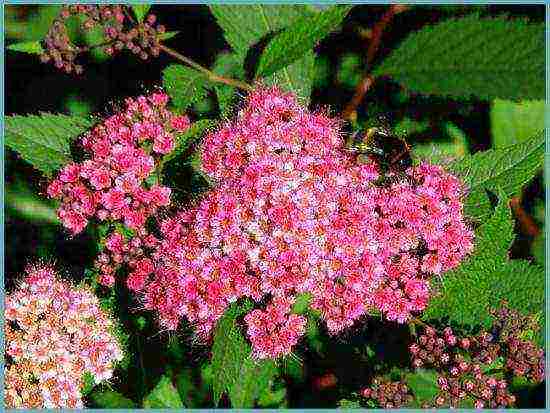
Spirea Bumald
Grown from seeds and by cuttings. Moreover, the second option is optimal for Boomald's spirea.
Among the variety of varieties of this species, the most famous can be distinguished.
- Anthony waterer - a bush with small leaves. The flowers are red. Flowering lasts more than 3 months. Combines with hydrangea.
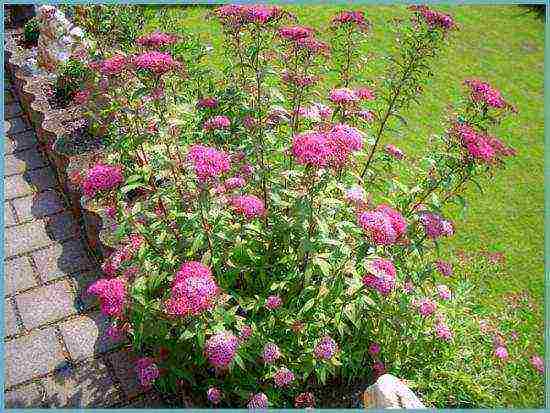
Anthony Waterer cultivar
- Darts Red - shrub about 60 cm high. The top has the same circumference. Growth is going up. The leaves are lanceolate, changing color during the growing period. During blooming, they are pink, later dark green, and in autumn they are red. Flowering begins in July and lasts until September. Crimson flowers are collected in shields.
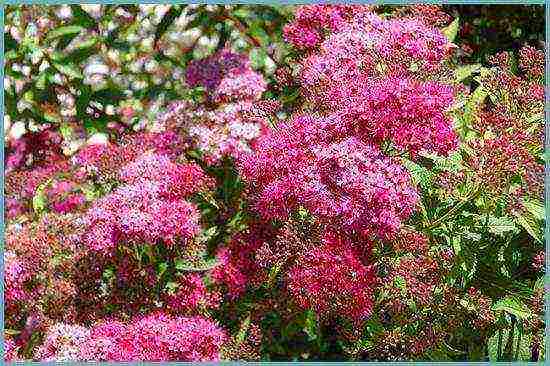
Darts Red variety
- Frebel - medium-sized shrub.Has purple leaves in autumn and spring. The flowering of the species continues for one and a half months. It is widely used for making flower arrangements in the form of bouquets.

Frebel's variety
- Curly - undersized one and a half meter shrub with brownish drooping shoots. The flowers are purple. Flowering begins in late July and lasts for one month. No seed ripening occurs.

Variety Curchavaya
Spirea Douglas
The homeland of this species is North America. Spirea Douglas is an upright shrub. The leaves are lanceolate, their length varies from 3 to 10 cm. The flowers are dark pink. The flowering period is 1.5 months. Flowering occurs in July and fruit ripens in September. Grown from seeds and by cuttings.

Spirea Douglas
Spirea willow
Light-loving species. It grows everywhere, but mainly near water bodies. It is protected in nature reserves.
The height of the shrub is 200 cm. The shoots are smooth, red-brown in color. The leaves are sharp, their length is about 10 cm. White and yellow spirea flowers gather in pyramidal panicles.

Spirea willow
The species is resistant to frost. Prefers moist soils with good mineral content. Grown from seeds and by cuttings. In Russia, it is found in Siberia and the Far East.
Growing spirea: video
Spirea in landscape design: photo
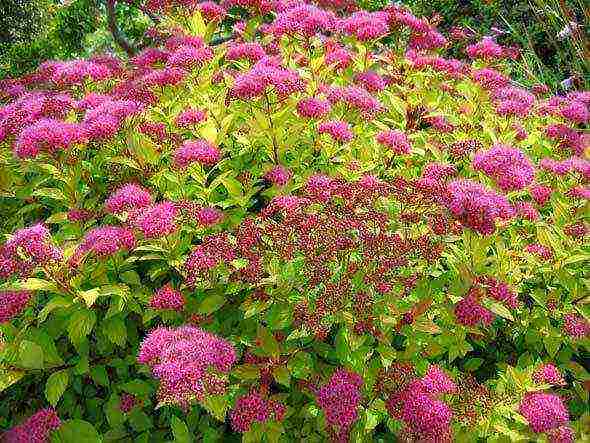


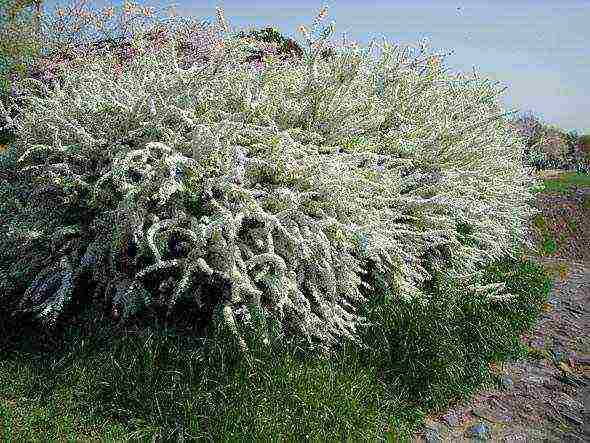
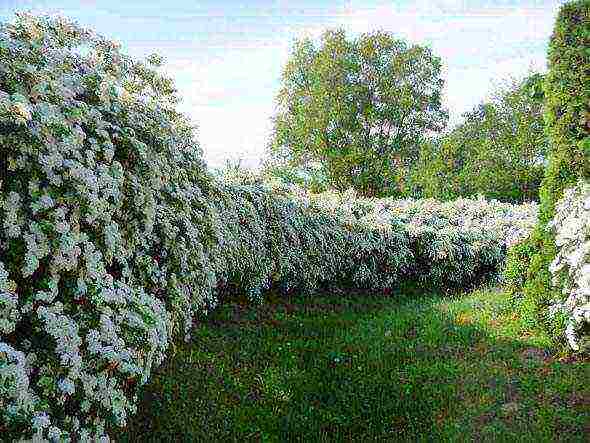
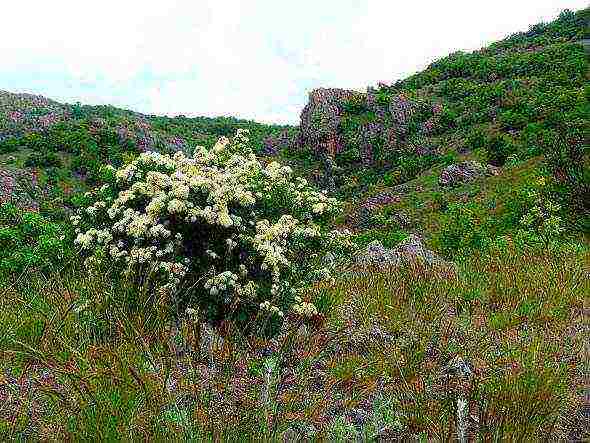
Spirea or meadowsweet is a common ornamental shrub of the Pink family. The plant is often used to decorate personal plots due to its abundant flowering and unpretentious care. Today, there are about 100 varieties that differ in color, height, as well as the duration and duration of flowering. From the article you will learn the names of the most interesting species and varieties of spirea.
Description and photo
The spirea plant is a deciduous shrub up to two meters high. The most common are weeping, erect, hemispherical, cascading and creeping forms. Depending on the variety and type, the plant has a different leaf plate, as well as different inflorescences. Spirea flowers are small, but very numerous. The color of the petals ranges from white to crimson. In some species, the inflorescences completely cover the entire bush, while in others they are located only on the upper or lower part of the shoots.
The plant is often used in landscaping because of its beautiful foliage, which in some species changes color during the season, as well as its decorative flowers. The shrub is unpretentious to care for, undemanding to climate and soil. Spirea grows and develops rapidly, but flowering is observed only 3 years after planting.
All types of this shrub are conventionally divided into two groups - spring-flowering and summer-flowering spireas.
Spring flowering species and varieties
This group blooms from late spring or early summer. The buds are located on last year's branches, which is important to consider when pruning a bush. Consider the spring variety of spirea.
Spirea gray

The bush reaches a height of up to 2 meters, has highly branched shoots with a pronounced tomentose pubescence. The leaves are colored gray-green, but the shade is lighter on the side. Small and numerous flowers are collected in small inflorescences located throughout the bush. Flowering is observed in May, fruits ripen by June.
This is a hybrid species that does not propagate by seeds; the plant is planted with young bushes, usually in small groups. Blooming shoots can be used to decorate bouquets.
The most interesting variety is Grafsheim. It has good winter hardiness, so it can be grown in cold regions.
Nippon
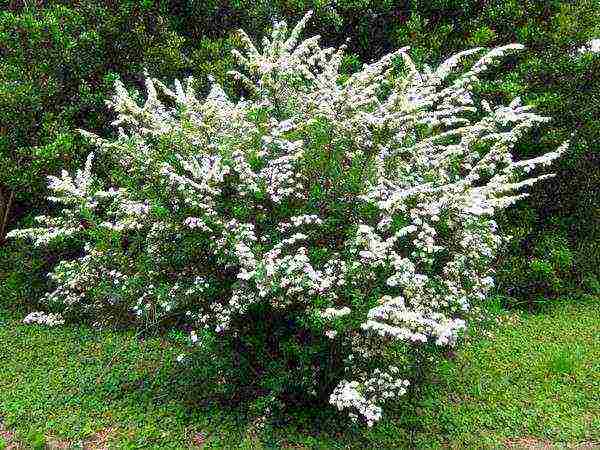
Originally from Japan, where it is commonly used to decorate the garden. The shrub reaches 2 meters in height, has a spherical shape. Long leaves of green color, can retain color until late autumn.
Flowering begins in late May with a duration of up to 25 days.The flowers are yellow-green in color and are collected in corymbose inflorescences, abundantly located along the entire length of the shoots. More often this type of spirea is used for single plantings. In Europe, two varieties are popular - Snowmand and Halvard Silver. They are compact and easy to care for.
Dubravkolistnaya

It is found throughout Europe, where the shrub is often used to decorate hedges. Spirea is represented by an erect shrub up to 2 meters in height. The shoots are often pressed to the ground under the weight of heavy inflorescences, so regular pruning is required. The leaves are pointed, the plate is green on top, gray on the bottom.
The color is small (up to 1.5 cm in diameter), collected in spherical white inflorescences. Flowering begins in mid-May, lasts up to 25-30 days. Grows rapidly, seed propagation is possible.
Spirea Argut

Slow growing plant, which is often used in decorative compositions with other perennials. Prefers light and dry places, which is important to consider when planting. Even in favorable conditions, it grows very slowly.
A distinctive feature of this species is the spreading crown, abundantly covering the entire bush. The leaves are strongly serrated and have a rich dark green color. The flowers are deep white in color, collected in umbellate inflorescences. Flowering begins in late spring, can last up to 30 days, pruning can only be done after the petals fall.
Gorodchaty

It can be found everywhere on the meadow and shrub steppes of Russia, the Caucasus and Central Asia. Prefers to grow in higher elevations.
It is a short shrub, rarely exceeding 1 meter in height. Has a loose green crown, collected from elongated gray-green leaves. It got its name for the crenellated edge of the leaf plate.
The flowers are white with a slight yellow tinge. Inflorescences are corymbose, located on short branches. The duration of flowering is only up to 20 days; it enters the fruiting stage from mid-July.
The crenate spirea has a highly developed root system, so it is recommended to plant it away from the beds with cultivated plants. It is this species that can often be found in city parks and forest plantations.
Spirea Thunberg
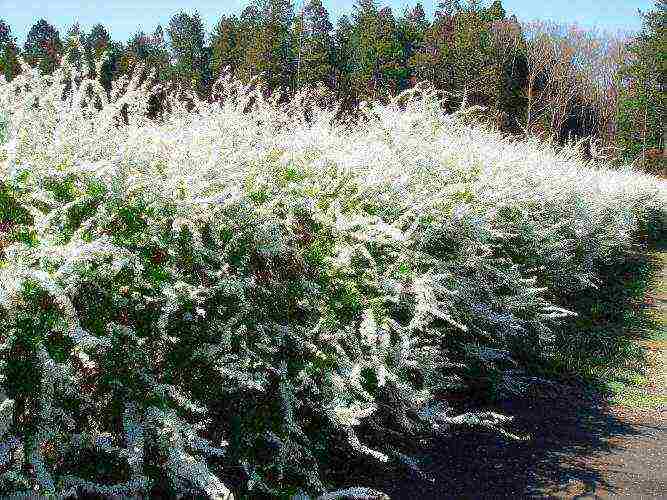
Under natural conditions, it grows in eastern countries - Japan, China and Korea. It looks especially beautiful on small hills, so it is often used to decorate alpine slides.
In a garden, the bush reaches a size of 1-1.5 meters, branches abundantly. On the shoots there are dense and small leaves, which acquire a golden hue in autumn. Inflorescences are represented by sessile umbrellas, consisting of small white flowers.
Flowering begins in May and flesh continues until the end of June. This type of spirea prefers well-lit places and does not tolerate low temperatures well, so in cold regions it is recommended to cover the bush for the winter.
Spirea Wangutta
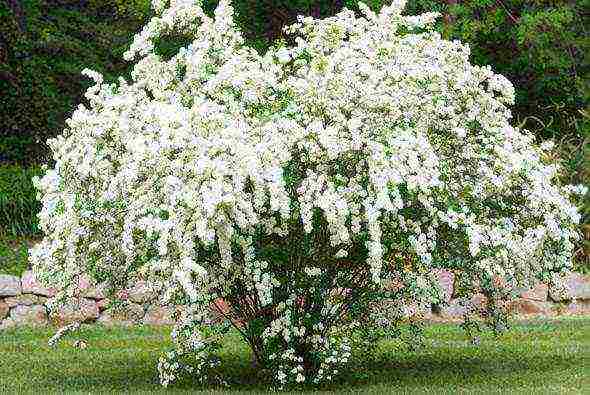
The plant is represented by a powerful and tall bush that reaches a height of up to 2 meters. It differs from other species in an interesting cascading crown shape, consisting of many small green leaves, obovate.
Flowers of deep white color are collected in hemispherical inflorescences that cover almost the entire length of the shoots. Flowering begins in late May and lasts up to 2-3 weeks. Secondary and less abundant flowering is sometimes observed, which occurs at the end of August. This is a shade-tolerant and not whimsical plant that can be used for single or multi-species plantings. Best combined with shrubs and coniferous trees.
Summer flowering varieties
In this group of spireas, flowers are formed on young shoots. Every year, old shoots dry up, new ones appear to replace them, on which flowers are actively developing.Below are descriptions of the most common types of this group of spirits.
Japanese
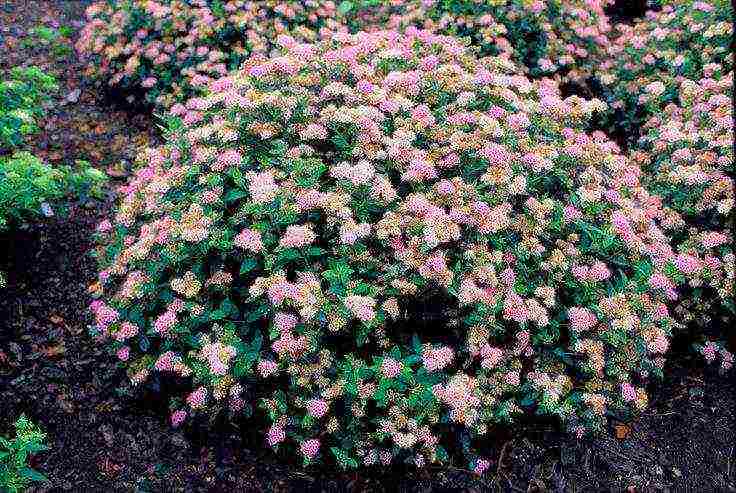
One of the most famous and popular varieties of spirits, which is often used to decorate a Japanese-style garden. It is represented by a compact, almost dwarf bush with abundantly pubescent shoots, which completely throw off their foliage in the fall. It is this type of spirea that is most often depicted in pictures in botanical reference books.
Flowering in favorable conditions lasts all summer, the average duration is 45 days. Flowers of a red or pink hue, collected in corymbose or paniculate inflorescences. Looks most advantageous in combination with yellow spirea varieties.
The species is represented by a large number of varieties, among which there are shrubs of various shapes, heights and decorativeness. The most popular of them are Shirobana, Macrophylla, Golden Flame, Little Princess.
White
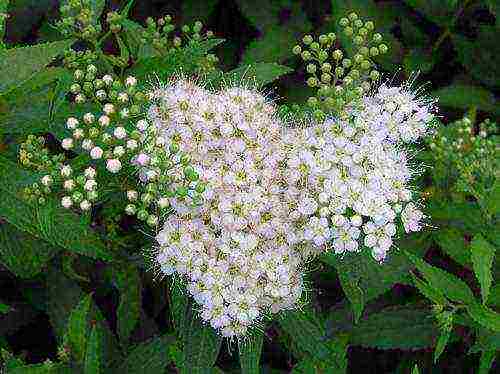
In its natural environment, it is often found in some states of North America. Spirea white is a small shrub with pubescent shoots of a red-brown color. On the branches there are a large number of small serrate leaves up to 7 cm long.
Flowers of a white shade are collected in long paniculate inflorescences with great decorative effect. Flowering lasts from July to late August.
Propagated both by seed and cuttings. It is best suited for creating hedges, but it is often used for single planting as well. Prefers moist soil, which should be considered when choosing a location.
Billard
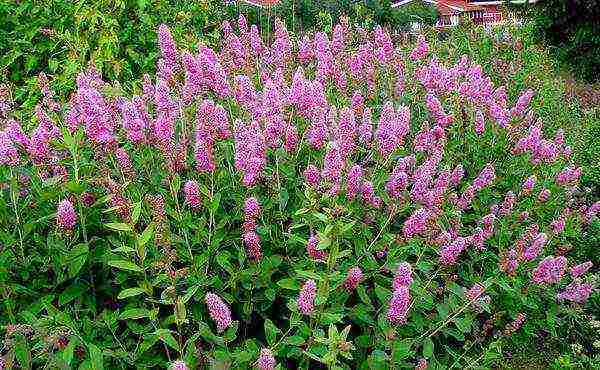
This is a hybrid form, bred by crossing the spirea willow and Douglas. It is ubiquitous throughout Russia, in some southern countries.
The shrub reaches a height of up to 2 meters, the spreading is moderate. On the shoots there are long, double-serrate leaves. Flowers are collected in dense paniculate inflorescences of a red or pink hue. Flowering begins in late July and flesh may continue until frost.
Billard's spirea is one of the most frost-resistant species, propagates exclusively by cuttings. Often used to create hedges, tolerates pruning well. Florists prefer to plant the Triumfans variety, which has the greatest decorative value.
Boomald

A popular hybrid of white and Japanese spirea. It is represented by a compact and low-growing perennial shrub, up to 75 cm high. The crown is spherical, formed from long lanceolate leaves. Flowers are collected in voluminous inflorescences of red, purple or pink color. Flowering lasts up to 50 days, starting in mid-July. The most popular varieties are Anthony Vaterer, Darts Red, Crispa and Froebel.
Willow
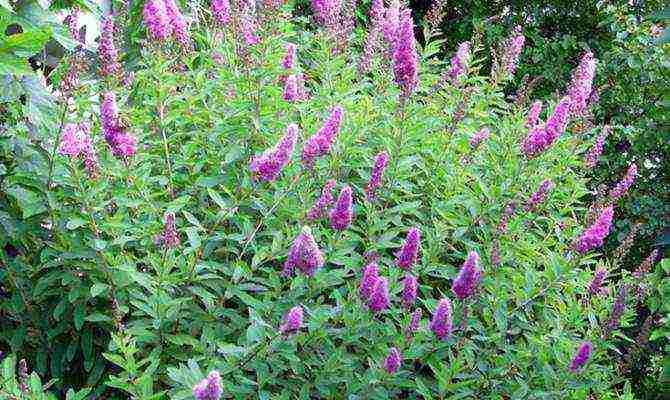
In the wild, it is often found in the central regions of Russia, America and Japan. Willow spirea is a tall upright shrub. On the shoots of red-yellow color there are large sharp-serrated leaves.
Delicate pink or white flowers are collected in a pyramidal panicle that reaches a length of up to 20 cm. Very frost-resistant appearance, suitable for areas with damp and infertile soil. Flowering begins only 4 years after planting, which is important to consider when using willow spirea for group plantings.
Spirea is a popular ornamental plant used in landscape design. Today, a large number of species and varieties have been bred, represented by bushes of various shapes and heights with beautiful small flowers of various colors. The plant develops quickly and is excellent for hedges.
